thinking about takeshi murakami

Thursday night, Jesse and I went to see the Murakami exhibit at the MOCA Geffen. At the time something about the exhibit rubbed me the wrong way. The work was pretty much what I expected. Nothing wowed me; overall my emotions were a cross between bored and superficially titillated. But I have been thinking about the exhibit for following two days and its impact on me has grown. The true measure of an exhibition is ultimately that it makes you think.
MOCA’s Murakami is an exhibition showing work spanning the artist’s career, showcasing large scale sculptures, paintings, animated shorts, and commercial products. The mix of work creates a complete spectrum from pop art to mass produced consumer products. Pop art itself has always been especially commercial, taking themes, styles and inspiration from “low” culture and translating them to sell-able multiple edition art works (think Warhol’s images of soup cans and Hollywood icons). Murakami takes things one step further by actually mass producing his characters as vending machine toys, stuffed animals, stationary and more. Where Warhol takes existing cultural icons and shows them in a new light; Murakami plays a similar game to those he is supposedly criticizing. While his early character DOB appears a Mickey Mouse clone (or perhaps bizzaro doppelganger) his newer works create completely original worlds of unique characters who are then used and reused, merchandised and licensed for advertising much like Disney or other commercial mascots.
But what do these mascots represent? Murakami’s worlds and their inhabitants are so cute that it’s sickening and sometimes so sickening that its cute. They are supersaturated both with color and detail. The works are high contrast and Technicolor. Their detailing has a fractal quality where each character or object presents us with a bewildering array of attachments, each with its own sets of eyes and even smaller set of attachments proceeding on and on to infinity. in this way they each form their own complete universes. in some cases the rooms of the gallery were set up to greatly intensify this effect. one room feature an all over wallpaper of his daisy characters, a huge circular painting of the same pattern but larger and then a spherical sculpture that was the 3d realization of these characters. Nevertheless, even when in 3 dimensions these characters were still 2 dimensional, just a relief on a spherical ball. The complete and totalizing nature of these universes is only reinforced by Murakami’s consistent stylistic perfectionism. Every line is crisp and every surface smooth; there’s no shading or blending.
hmm. seem to have lost my train of thought. But I would also like to note that there is a lot of religious symbolism/overtones mixed in with the psychedelic consumerism.



Adam
this 2d aspect of the work you mention, it is really what’s special about it. as i see it, anyway, while warhol removes himself from his subject in order to make some sort of commentary, murakami proposes something new — he submits to his (weird) subject. the former is ‘ironic detachment,’ which we’re very familiar with; maybe the latter is ‘ironic attachment?’
i loved the exhibit, i loved its humble relationship to its commercialism. there is a risk of selling out when you think you are above commerce, but none here. that is what ‘superflat’ means to me: a vibrant color, a smooth texture, and a moral framework laid out not as a pyramid with an interior, but rather as the surface of a hollow sphere.